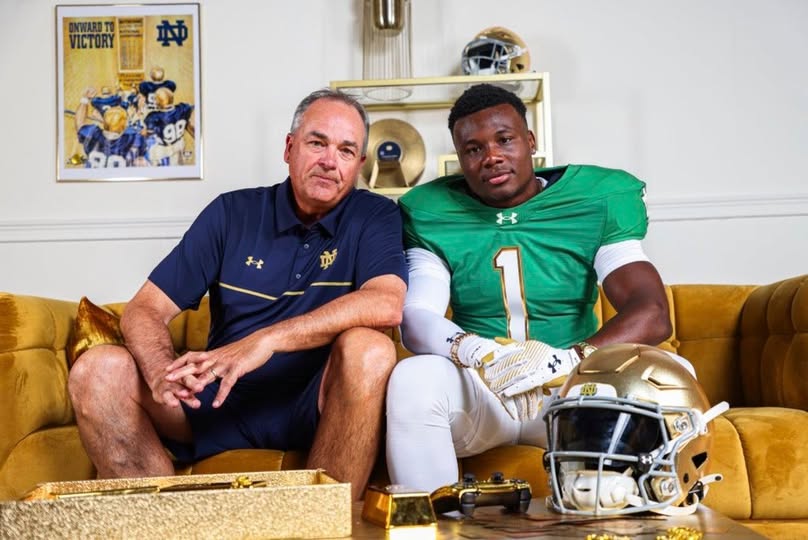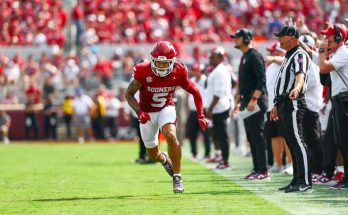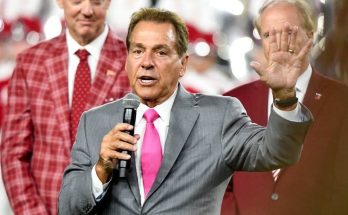As the 2026 recruiting class begins to take shape, Notre Dame football is putting the finishing touches on a pivotal month of official visits, closing out June with a wave of momentum that could define the future of Marcus Freeman’s tenure in South Bend. With the echoes of the Golden Dome resounding across campus, the Fighting Irish hosted some of the nation’s top talent in a calculated effort to reassert their place among college football’s elite. June—arguably the most important month of the recruiting calendar—wasn’t just about giving recruits a glimpse of tradition, but showing them what the next generation of Notre Dame football will look like.
Over the course of several weekends, the Notre Dame staff pulled out all the stops. From high-level presentations and position-specific breakdowns to bonding experiences with current players and personal time with Freeman himself, these visits were comprehensive and intentional. Notre Dame’s strategy wasn’t just to impress—it was to connect, to educate, and to inspire belief that South Bend is the right place to build a future. And for many recruits, the message landed.
One of the cornerstones of this final June weekend was the presence of several top-100 prospects who already hold high-profile offers from powerhouse programs like Alabama, Georgia, Ohio State, and Texas. Yet, it was Notre Dame that had their undivided attention. The coaching staff has sharpened its focus on cultural fit—emphasizing not only academic excellence and character, but how each prospect can become part of something larger than football. Recruits met with university faculty, experienced dorm life, and even sat in on team-led film sessions, all curated to provide a sense of belonging in a program rooted in history but aiming boldly toward the future.
Among the headline visitors was five-star offensive tackle Jamari Knox from California, a mammoth presence at 6-foot-6 and 310 pounds who has been on Notre Dame’s radar since his sophomore year. Knox praised the coaching staff’s detailed developmental plan, calling it “the most professional and structured approach” he’s seen during his process. While Knox remains uncommitted, sources indicate that Notre Dame made a significant leap in his recruitment. His family, too, was reportedly blown away by the culture on display, which could prove crucial down the line.
Quarterback recruiting has also remained a critical component of Notre Dame’s 2026 efforts, and this weekend gave the Irish a chance to solidify their standing with one of the top passers in the nation: Elijah Carver, a strong-armed, dual-threat playmaker from Texas. Carver, who has drawn comparisons to Bryce Young for his poise and creativity, connected with offensive coordinator Gerard Parker and spent several hours going over play concepts, route trees, and pre-snap reads. His visit reportedly exceeded expectations, with one insider stating that Carver “felt more comfortable at Notre Dame than anywhere else he’s visited.”
In the trenches, the Irish have made a clear statement that they’re looking to reload with size and strength. Defensive lineman Tyson Riddick, an athletic freak out of New Jersey with a 4.8 40-yard dash at 280 pounds, described his visit as “eye-opening.” Riddick emphasized how welcomed he felt by both the players and staff, noting that the coaching team made a point of outlining how he’d be used in Notre Dame’s scheme. His versatility makes him a valuable chess piece, and it’s believed Notre Dame is now firmly in his top three.
Perhaps the most compelling storyline of the weekend was the visit of four-star safety Marcus Lee from Florida, a ball-hawking defensive back with elite instincts and a 3.9 GPA. Lee’s recruitment had been trending away from Notre Dame early in the spring, but the Irish coaching staff didn’t give up. They remained in constant contact, emphasized his potential fit in the secondary, and highlighted the university’s elite academic profile. The persistence paid off. Following his visit, Lee publicly declared that Notre Dame was “back in it in a major way.” While a commitment isn’t imminent, the Irish have put themselves in position for a potential fall announcement.
The atmosphere surrounding these visits was electric but focused. Marcus Freeman and his staff, including recruiting coordinator Chad Bowden and defensive coordinator Al Golden, have made it clear that they’re not simply collecting talent—they’re building a team. That message has resonated, especially with parents. Across the board, feedback from visiting families was glowing, with many praising the university’s holistic approach to player development. One parent, whose son is a top-250 linebacker from Georgia, said, “At other places, you feel like you’re visiting a football program. At Notre Dame, you feel like you’re visiting a family. That makes all the difference.”
Another key component of the visits was the peer-to-peer interactions. Recruits were paired with current Notre Dame players who served as hosts, providing insights into daily life on campus and in the locker room. That initiative, coordinated by the player leadership council, gave the visiting prospects an unfiltered look at team culture. Whether it was sharing meals at the Morris Inn, workouts inside the Gug, or hanging out at Coach Freeman’s house for a team BBQ, recruits saw a brotherhood that goes deeper than just game days.
On the coaching side, Notre Dame’s staff was methodical. Each player had a personalized itinerary that included not only film sessions and meetings, but also tailored academic presentations and interactions with alumni in their potential fields of study. That academic emphasis remains a major selling point. In an era where NIL, transfer portals, and immediate playing time dominate the headlines, Notre Dame still leans on the value of the 40-year decision—not just the four.
That said, NIL was not left out of the equation. Notre Dame’s Irish Players Club and its new NIL infrastructure were presented in a transparent, future-forward fashion. Recruits and their families met with key staff members who explained how Notre Dame athletes are being empowered to monetize their brands in meaningful and responsible ways. It was a refreshing contrast to the chaotic messaging at some other schools, where NIL is often dangled as a cash-first carrot. At Notre Dame, it was portrayed as a long-term asset—leveraged through alumni connections, national visibility, and character-driven branding.
From top to bottom, the month of June was a masterclass in how to manage the modern recruiting process. Freeman’s program appears to have struck a balance between embracing the evolving landscape of college football and staying true to the university’s enduring values. That duality—innovation without compromising tradition—is what makes Notre Dame so unique, and it’s clearly resonating.
As the calendar flips to July and the dead period begins, Notre Dame finds itself in an enviable position. Several high-priority targets are now trending in their direction, and a number of silent commitments could soon go public. With a current class that already includes four-star linebacker Owen Tatum, quarterback commit Ryder Monroe, and wideout Demari Barnes, the Irish are quietly assembling one of the most complete 2026 groups in the nation.
The closing stretch of June’s official visits has not only given the Irish momentum—it’s set the stage for a potentially program-defining recruiting class. The relationships built over the past few weeks, the impressions left on families, and the vision laid out by Marcus Freeman all point to a singular goal: bringing Notre Dame back to the pinnacle of college football. And if this month was any indication, the Irish are getting closer by the day.



